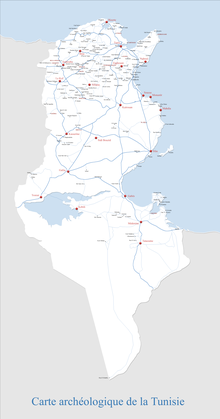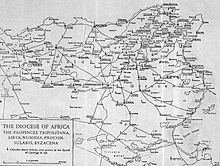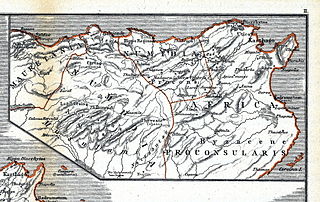
Buruni is an ancient city of the Maghreb, in North Africa. The city has been identified with ruins at Henchir-El-Dakhla in Tunisia.

Buruni is an ancient city of the Maghreb, in North Africa. The city has been identified with ruins at Henchir-El-Dakhla in Tunisia.
Buruni, was an ancient Roman city of the Bagradas Valley identifiable with Henchir-El-Dakhla in modern Tunisia. [1] There is no record of the city in Punic or pre Roman Berber, times, and is presumed to be a Roman foundation, probably of coloni status.
The Bagradis valley became Roman after the Third Punic War about 146BC [2] and it quickly became an important region for agriculture, [3] with the rolling plains home to numerous Imperial estates. The area around Buruni fell to the Vandal Kingdom around 423 and for a century was ruled by the Arian kings until in 533 the Orthodox Byzantines replaced them.
The area was held by Byzantium until the Muslim conquest of the Maghreb in the end of the 7th century.
The saltus burunitanus (CIL VIII 10570 = ILS 6870) is an ancient Roman era document. The document is a letter of reply from emperor Commodus regarding a complain by a group of peasants on an imperial estate in Buruni complaining of maltreatment by the estate manager. [4] [5] One Lurius Lucullus, wrote on behalf of the peasants that the procurator of the estate had arrested and flogged some of the workers even those who were Roman citizens. [6]
The document names one official Allius Maximus, [7] an official of the rank of conductor, as subject of the major part of the complaint. [8] The text was published in 1880, by Dr. Dummartin, was one of dozen similar petitions to the emperor at the time. The Saltus Burunitanus shines a light on the social structure and lifestyles of Roman North Africa in the early empire. [9] A time when the Maghreb was much more fertile and supported a much larger population, than today.

Some time after Commodus a Christian community formed in the city which was known as the episcopus Buronitanus. [10] The community developed as an ancient Latin Rite Bishopric of the Roman province of Africa Proconsolare, suffragan of the Archdiocese of Carthage. The only bishop of Buruni known to us, was Fausto, a Catholic mentioned at the end of the 5th century by Victor of Vita in his history of the Vandal persecution.
Today the diocese of Buruni survives as titular see of the Catholic Church. [11] [12] The current bishop is Daniele Libanori.
Known bishops

The history of North Africa during the period of classical antiquity can be divided roughly into the history of Egypt in the east, the history of ancient Libya in the middle and the history of Numidia and Mauretania in the west.

Africa was a Roman province on the northern coast of the continent of Africa. It was established in 146 BC, following the Roman Republic's conquest of Carthage in the Third Punic War. It roughly comprised the territory of present-day Tunisia, the northeast of Algeria, and the coast of western Libya along the Gulf of Sidra. The territory was originally and still is inhabited by Berbers, known in Latin as the Mauri, indigenous to all of North Africa west of Egypt. In the 9th century BC, Semitic-speaking Phoenicians from West Asia built settlements along the coast of the Mediterranean Sea to facilitate shipping. Carthage, rising to prominence in the 8th century BC, became the predominant of these.

The name early African church is given to the Christian communities inhabiting the region known politically as Roman Africa, and comprised geographically somewhat around the area of the Roman Diocese of Africa, namely: the Mediterranean littoral between Cyrenaica on the east and the river Ampsaga on the west; that part of it that faces the Atlantic Ocean being called Mauretania, in addition to Byzacena. Thus corresponding somewhat to contemporary Morocco, Algeria, Tunisia and Libya. The evangelization of Africa followed much the same lines as those traced by Roman civilization. From the late fifth and early sixth century, the region included several Christian Berber kingdoms.

Roman Carthage was an important city in ancient Rome, located in modern-day Tunisia.
Ruspe or Ruspae was a town in the Roman province of Byzacena, in Africa propria. It served as the episcopal see of Saint Fulgentius of Ruspe. It is now a Roman Catholic titular bishopric.

Roman Tunisia initially included the early ancient Roman province of Africa, later renamed Africa Vetus. As the Roman empire expanded, the present Tunisia also included part of the province of Africa Nova.
The Lex Manciana is a Roman law dealing with tenancy agreements of imperial estates in Roman North Africa.

Pupput, also spelled "Putput", "Pudput", "Pulpud" and "Pulpite" in Latin, sometimes located in Souk el-Obiod ou Souk el-Abiod, is a Colonia in the Roman province of Africa which has been equated with an archaeological site in modern Tunisia. It is situated on the coast near the town of Hammamet, between the two wadis of Temad to the north and Moussa to the south. Much of the Pupput is buried under modern holiday developments which have been built over the major part of the site.

Girus Tarasii was a town in the Roman province of Numidia that became a residential episcopal see. It is tentatively identified with ruins situated at what is now called Henchir-Tarsa in Algeria.

Calama was a colonia in the Roman province of Numidia situated where Guelma in Algeria now stands.
Henchir-Tebel is a town and archaeological site in Al Qayrawān, Tunisia, near Kairouan

Henchir Mettich is a town of the Bagradas Valley region in Tunisia, c.50 km west of the ancient city of Carthage. The area around Henchir Mettich is currently a semi-arid district of mostly barren hills, some of which are currently cultivated with olive trees.

Henchir-El-Hatba is a village and an archaeological site in Tunisia. It was a Roman Catholic diocese.

Dzemda is a locality in Tunisia.
Canapium was a Roman–Berber town in the province of Africa Proconsolare. Its stone ruins are located near Henchir-El-Casbath, in the region of Mornag, Tunisia.
Theudalis, also known as Teudali, was a Roman era civitas (town) of the Roman province of Africa Proconsularis. The ancient city is tentatively identifiable with ruins at Henchir-Aouam in Tunisia.
Sidi-Meskin, anciently known as Thunusuda, is a railway town, and archaeological site in the Gouvernorat of Jendouba, Northern Tunisia. It is located in the Medjerda valley at 36.45N, 8.66E, outside of Bou Salem, and is near to Djendouba, Mechtat el Anad, and Djebel Bou Rbah. The town is located at an elevation of 430 meters above sea level, and has a mosque and railroad station.

Limisa is a town and archaeological site in Kairouan Governorate, Tunisia. It is located 50 kilometers west of kairouan. The town was a Roman Catholic diocese.

Numidia was a Roman province on the North African coast, comprising roughly the territory of north-east Algeria.
The diocese of Presidio is a suppressed and titular see of the Catholic Church.